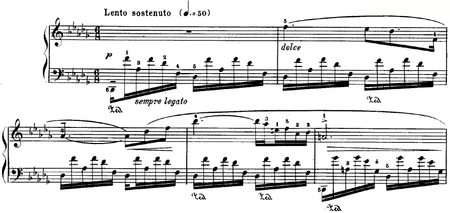|
Nocturnes, Op. 27 (Chopin)
 The Nocturnes, Op. 27 are a set of two nocturnes for solo piano composed by Frédéric Chopin. The pieces were composed in 1836[1] and published in 1837. Both nocturnes in this opus are dedicated to Countess d'Appony. This publication marked the transition from triplets of nocturnes to contrasting pairs.[2] Whereas the Nocturnes, Op.9 and Op. 15 included three nocturnes each, the remainder of Chopin's nocturnes published during his lifetime were in sets of two. David Dubal feels that the pieces are "more aptly described as ballades in miniature".[3] Blair Johnson states that these two nocturnes are "two of the most powerful—and famous—nocturnes [Chopin] has ever penned" and that these nocturnes are "virtually unrecognizable" to the nocturne tradition of John Field.[4] Nocturne in C-sharp minor, Op. 27, No. 1 The Nocturne in C-sharp minor, referred to as Nocturne No. 7 in the context of the complete set of Chopin's Nocturnes, is initially marked larghetto and is in 4 The opening alternates between major and minor and uses wide arpeggios, commonly found in other nocturnes as well, in the left hand; such arpeggios require a wide left hand to play smoothly. James Huneker commented that the piece is "a masterpiece",[5] pointing to the "morbid, persistent melody" of the left hand.[5] The più mosso uses mostly triplets in the left-hand and modulates to A♭ major in measure 49. It ends with a cadenza before transitioning back to the primary theme. For David Dubal, the più mosso has a "restless, vehement power".[6] Huneker also likens the più mosso to a work by Beethoven due to the agitated nature of this section.[5] The coda "reminds the listener of Chopin's seemingly inexhaustible prodigality" according to Dubal[6] while Huneker calls it a "surprising climax followed by sunshine" before returning to the opening theme.[5] In theatreThe first duet of the ballet In the Night by Jerome Robbins (1970) was choreographed to this piece. Excerpts
Nocturne in D-flat major, Op. 27, No. 2 The Nocturne in D-flat major, referred to as Nocturne No. 8 in the context of the complete set of Chopin's Nocturnes, is one of Chopin's more popular compositions. It is initially marked as lento sostenuto and is in 6  Blair Johnston calls the main cadence, near the end of the piece, "one of the most glorious moments in Chopin's entire output".[4] Johnston also calls the piece "one of [Chopin's] most graceful essays in fioritura ornamental practices".[4] Huneker states that the piece "really contains but one subject, and is a song of the sweet summer of two souls, for there is obviously meaning in the duality of voices."[7] The piece contains a harmony of broken chords which is played with the left hand, a habit Chopin had when composing his nocturnes,[8] while the right hand plays the main melody, often with the addition of a second voice. Various sections consisting of grace notes and polyrhythms add to the delicate and somewhat melancholic mood that the piece conveys. The piece occasionally has been featured in popular culture, such as in the 1977 film The Spy Who Loved Me,[4][9] the 1998 Russian film The Barber of Siberia, and the webcomic Saturday Morning Breakfast Cereal.[10] References
External links
|

